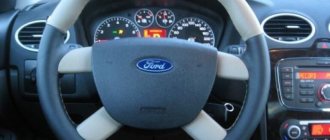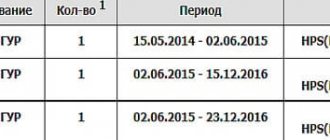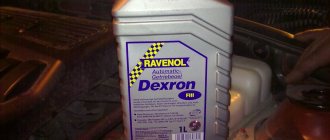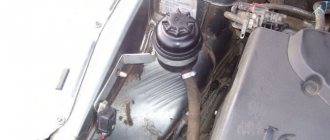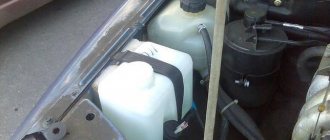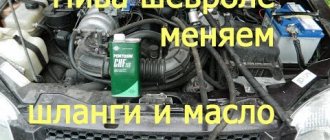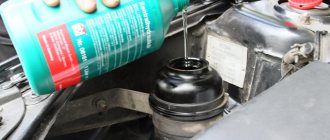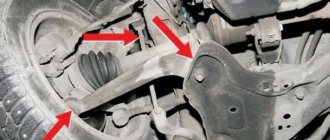| Replace the fluid in the power steering system if it is excessively dirty. The manufacturer does not give clear recommendations on the frequency of replacing fluid in the hydraulic system, so we recommend replacing it after six years, regardless of its condition. |
What kind of power steering fluid should I fill?
| For use in the hydraulic system of the amplifier , the factory recommended fluid is Pentosin Hidraulik Fluid CHF11S oil. However, for technological reasons, cars starting with VIN No. X9L21230040005880 use Shell Donax TA D-21631 (Dexron II) hydraulic fluid in the hydraulic system, and with VIN No. X9L21230040006248 - Ravenol Dexron II D. Cars filled with Shell Donax oil have a mark on the tank - “*”, and cars filled with Ravenol Dexron II D are marked “R”, but on cars of the latest production these marks may not be present. |
| Dexron II fluids (red) cannot be mixed with Pentosin Hidraulik Fluid CHF11S (green). It is possible to completely replace the fluid after flushing the power steering hydraulic system. |
| When using Dexron II fluids, reduce the period of use by half the recommended time. |
How much fluid do you need to replace?
– 1.7 l.
CHECKING THE LEVEL AND ADDING FLUID IN THE POWER STEERING RESERVOIR
| You will need power steering fluid. |
| The power steering reservoir is installed on the left side of the engine compartment near the bulkhead and is connected to the pump and steering mechanism with flexible hoses. |
| 1. Check the fluid level in the power steering pump reservoir. To do this, unscrew the tank cap. |
| 2. The oil level should be between the marks on the dipstick mounted in the plug. |
| 3. Add oil if necessary. |
REPLACING POWER POWER FLUID
| 1. Remove the coupling bolt of the power steering reservoir reservoir bracket. |
| 2. Unscrew the tank cap. |
| 3. Remove the reservoir from the bracket and drain the liquid from the reservoir into a suitable container. |
| 4. Loosen the clamp securing the outlet hose and remove the hose. |
| 5. To prevent fluid from leaking out, plug the hole in the tank fitting and lower the end of the outlet hose into a container for drained fluid. Start the engine and, turning the steering wheel from lock to lock in both directions three or four times, drain the old fluid while adding new fluid. Repeat the operation until fresh fluid appears from the outlet hose. |
| Carefully monitor the fluid level in the reservoir and do not allow air to enter the power steering pump. This may damage the pump. |
| 6. Install the tank in the reverse order of removal. |
| 7. Add fluid to the level of the upper mark on the dipstick of the reservoir plug. |
| 8. Bleed the power steering system (see here) |
Video
Answers (3)
The power steering of the Chevrolet Niva is filled with Pentosin Hydraulic Fluid CHF11S VW52137. It is filled for the entire life of the car and does not need regular replacement.
In case of fluid replacement, in addition to the original one, you can use, for example, GM (article 19 40 715).
special for power steering. There are many of these, not necessarily the original one, since it is expensive and can still be difficult to find.
Instead of Pentosin, you can fill it with Mannol CHF - its analogue. You can also add Dexron IID while flushing the system.
Changing the power steering fluid in a Niva Chevrolet
At the moment, almost all modern car models are equipped with power steering. It allows you to simplify wheelbase control and make it easier. This is especially true for a car like the Chevrolet Niva, which belongs to the SUV class. The Niva's mass is one and a half tons, and in off-road conditions it is required that the wheels react sharply to turning the steering wheel. In such conditions, there is an increased load on the steering, which is fraught with breakdowns, which may result in a leak. If the level in the expansion tank drops at the slightest level, you must immediately add fluid to the Niva Chevrolet. You can do this yourself, without visiting a service station.
Reservoir for windshield and brake fluid.
Another filling capacity of the Chevrolet Niva is two glass washer reservoirs, the capacity of which is five and two liters.
This model has two independent braking systems. The working one has a hydraulic drive, the parking one has a mechanical drive. The contours are separated from each other.
The hydraulic drive includes a special tank made for brake fluid.
- DOT-4 brake fluid is suitable for half-liter hydraulic brakes. The product has improved characteristics and has a boiling point of over 235 degrees. Well suited for regions with low ambient temperatures.
- SAEJ1703, FMSS116 are used for the entire hydraulic system and clutch release (0.15 l). The synthetic product provides good lubrication and reduces oxidation at high temperatures.
- The tank lid hatch hinges, door and hood locks require VTV-1 and FIOL-1 greases. Hinges of steering rods and cardan shafts - ShRB-4, Litin 2, Esma.
- The air conditioner also has two tanks. One of them is for oil (0.22 l), the other is for refrigerant (0.650 kg).
Chevrolet Niva reservoirs for refilling liquids and lubricants are quite reliable and convenient when you need to make a replacement.
Various tags and sensors make it possible to carry out control almost immediately, which allows you to avoid an emergency situation.
changing the oil in a gur sheviniva - logbook of the 2009 Chevrolet Niva L on DRIVE2
I forgot to take a camera and take a picture of how it was and what happened. And it’s -15 outside. So I didn’t like the condition of the thick hose, all cracked, and I decided to replace it. At the same time, I need to change the oil because Neither I nor the old owner know what kind of oil was poured in there (apparently it hasn’t been changed from the factory), but the color is green. After reading the forums, I decided to take the red SHELL DONAX. I drained the old one, changed the reservoir for a new one (since there is a filter there, I decided to be on the safe side and replace it), filled in new oil, pumped it out. The old one looks darkish but without impurities. One minus is that you need to bleed the air, but I don’t know where this valve is. I’ll look for it. I bleed the air through the open tank cap. I hope nothing breaks))) ah Yes, for some reason the book says that the oil volume in the power steering is 1.7, but I got 1.3 and the old one came out of the system. The level in the tank is still there. The steering wheel is turned in all directions, everything works fine. There is no more hissing when the steering wheel is all the way to the side (but this may be due to the tank cap) I’ll keep an eye on what might change. Oil-480 for 1l hose 16-1m 140r tank-350r
Chevrolet car repair manuals and tips
How to repair the power steering of a Chevrolet Niva
Today, it is perhaps difficult to imagine a car that does not have hydraulic power steering. If such cars are found, they are considered transport of the last century. Thanks to the presence of power steering on a Chevrolet Niva, wheelbase control becomes very simple, and most importantly, easy.
The Chevrolet Niva comes from a family of SUVs, which necessitates such a function. After all, it is very difficult to drive a car that weighs more than 1.5 tons, and the road leaves much to be desired. And on highways or highways it is very difficult to imagine driving a Chevrolet Niva at high speed without power steering.
But often there are malfunctions in the operation of the power steering, which must be corrected immediately, otherwise there is a risk of the steering wheel jamming. In such cases, you can use the services of a car service, but the cost of repairs or replacement of components will cost a pretty penny. Therefore, the best option would be to carry out repairs in your garage with your own hands.
Also interesting: Why do headlights sweat from the inside and what to do about it
What is power steering
This is a device that allows you to control the wheels of a car using the steering wheel without much physical effort. Anyone who has never driven a car without power steering will find it very difficult to imagine the importance of this function. The amplifier is especially indispensable in heavyweight cars, which include the Chevrolet Niva.
1. Pump; 2. Tank; 3. Valve system; 4. Manual hydraulic rack.
A more clear location of these components in the car is shown in the photo below.
power steering diagram
Power steering pump. The pump is the main element in performing the function of power steering. It is a device filled with an oil mixture. The drive operates from the car engine. The pump is driven by a belt drive. Inside, the pump consists of a special chamber, shaft and blades.
There are also two holes, one of which is the entrance, and the second is the exit. At the inlet the pressure is always equal to atmospheric pressure, and at the outlet it is much higher, about two atmospheres. When the engine is running, the pump is automatically activated, it pumps liquid to a certain pressure and maintains the pressure.
Power steering pump diagram
Important! It is necessary to periodically monitor the fluid level, which can lead to failure of the power steering pump.
Power steering fluid reservoir
Rotary valve. This device performs an auxiliary function. When the steering wheel is rotated by the driver, the rotary valve contributes to the steering power, and when there is no such need, for example, when driving in a straight line, it has no effect on the wheel alignment.
Rotary valve operation diagram
Steering rack. The design is a conventional mechanical rack, to which hydraulic lines are connected. These lines are the driving force involved when changing the wheel alignment angle. Schematically, the rail represents the structure shown in the photo below.
Steering rack diagram
Power steering pump repair
1. Remove the power steering drive belt, sump protection and engine compartment mudguards. 2. All liquid is pumped out from the tank. 3. Use a screwdriver to lock the pulley and loosen the fastening of the bolts to the flange. 4. The fastening bolts are completely unscrewed and the pulley is removed. 5. Drain the remaining liquid from the device into a special jar. 6.
The hose clamp is loosened and the hose itself is removed. 7. The bolt fitting is unscrewed and removed. 8. The hose tip must be sealed with special washers. 9. Unscrew the fasteners. 10.The bolt that connects the pump to the oil filter is also unscrewed. 11.The upper mounting bolt is unscrewed and the power steering pump itself is removed.
1. Disassembling the pump. 2. Fault assessment. 3. Repair. 4. Assembling the device or replacing it.
power steering pump removed from car
The photo shows an assembled pump from a Chevrolet Niva car. Getting to the first point, it is worth noting that repairing the power steering device is feasible only in 40% of cases, all others simply require replacement with a new one.
Disassembling the device: 1) Unscrew all fastening screws on the cover. 2) The inside of the device is removed. 3) After removing the internal parts, you need to remember their order of arrangement and fastening.
1. It is necessary to clean the internal parts to find the cause of the malfunction. Disassembled power steering pump 2. If, when removing the cover, wear of the internal parts or their defects is detected, then you need to purchase new parts or try to remove the defects. If the defects are severe, then repair will no longer help.
The photo shows wear on the pump race, which cannot be repaired. 3. The cause of the malfunction may also be wear of the bearing or oil seal. 4. The shaft has sharp edges, which wear out over time, enlarge and burrs appear. They need to be removed. 5. The cylinder is taken and examined. Its surface should be smooth and without chips or burrs. In this case, they need to be eliminated.
So, knowing the faults, you can proceed directly to eliminating them and carrying out repairs.
Also interesting: How to change the handbrake cable on a Chevrolet Niva
1) Rags; 2) Solvent; 3) Sandpaper with maximum grit P2000. 4) Triangular file. 5) Drill with a diameter of 12 mm. 6) Drill or screwdriver.
Cylinder. So, first we will try to remove defects on the inside of the cylinder. To do this, we make a homemade sanding wheel. Take sandpaper with a grit of P2000 and wrap it around the drill in two or three turns. To keep it stationary, we attach a sandpaper with a drill at the base of the drill, as shown in the photo below.
Sanding attachment
Next, we fix the cylinder vertically in a vice and begin sanding the entire inner surface of the cylinder with sandpaper.
Important! Severe irregularities cannot be eliminated this way, so it is better to buy a new cylinder. If the defects are minor, but they are noticeable, then they are ground off within a few minutes. After sanding, wipe the surface with solvent to remove small particles. It is very important!
Bearing repair. If there are defects in the bearing or oil seal, they must be removed and replaced with new ones. The bearing and seals cannot be repaired.
Shaft repair includes turning the grooves until they are completely smooth. To do this, we will use sandpaper type P1000. We fold it in half and insert the corner end into each groove. It is necessary to grind off all the irregularities and burrs in the groove. You can use a triangular file or rasp, put sandpaper on it and also grind all the corners, as shown in the photo below.
Removing burr gur
If the internal parts of the device were not severely damaged and the repair helped eliminate them, then we proceed to the final stage - assembling the power steering pump. If it cannot be repaired, then it is better to purchase a new one.
Assembling the pump and installing it in place is carried out in the reverse order of removing the parts and the device itself.
Important! After repairing the power steering pump, unnecessary sounds may appear, especially with significant rotations of the steering wheel. Don’t be alarmed, this is a normal phenomenon - the repaired parts rub into new places. After 10-20 km, this sound will disappear.
1. when turning the steering wheel in different directions, force is required, as if there was no power steering; 2. extraneous noise or hum in the pump; 3. periodic failures in the operation of the hydraulic booster.
Therefore, pay attention to such important factors and promptly repair or replace faulty parts. Happy renovation work!
Replacing fluid in the power steering hydraulic system of Niva Chevrolet
Replace the fluid in the power steering system if it is excessively dirty.
The manufacturer does not give clear recommendations on the frequency of replacing fluid in the hydraulic system, so we recommend replacing it after six years, regardless of its condition.
For use in the hydraulic system of the amplifier, the manufacturer recommends a fluid - Pentosin Hidraulik Fluid CHF11S oil. However, for technological reasons, on cars starting with VIN No. X9L21230040005880, the hydraulic system uses Shell Donax TA D-21631 (Dexron II), and with VIN No. X9L21230040006248 - Ravenol Dexron II D.
Cars filled with Shell Donax oil have a mark on the tank - “*”, and cars filled with Ravenol Dexron II D - “R”, but on cars of the latest production these marks may not be present.
Dexron II fluids (red) cannot be mixed with Pentosin Hidraulik Fluid CHF11S (green). It is possible to completely replace the fluid after flushing the power steering hydraulic system.
When using Dexron II fluids, reduce the period of use by half the recommended time.
1. Remove the coupling bolt of the power steering reservoir reservoir bracket.
2. Unscrew the tank cap.
3. Remove the reservoir from the bracket and drain the liquid from the reservoir into a suitable container.
4. Loosen the clamp securing the outlet hose and remove the hose.
5. To prevent fluid from leaking out, plug the hole in the tank fitting and lower the end of the outlet hose into a container for drained fluid.
Start the engine and, turning the steering wheel from lock to lock in both directions three or four times, drain the old fluid while adding new fluid.
Repeat the operation until fresh fluid appears from the outlet hose.
Carefully monitor the fluid level in the reservoir and do not allow air to enter the power steering pump. This may damage the pump.
6. Install the tank in the reverse order of removal.
7. Add fluid to the level of the upper mark on the dipstick of the reservoir plug.
Bleeding the power steering system
The need for bleeding arises when air enters the hydraulic system during repair work or when there is a loss of tightness during operation. A sign of air in the system is the steering wheel jamming when you try to turn it sharply. In addition, the pump makes increased noise when the steering wheel is turned, and the fluid in the reservoir usually foams.
You will need an 8 key.
1. With the steering wheel in the middle position, run the engine for 10–15 seconds.
2. Stop the engine without turning the steering wheel.
3. Turn the steering wheel all the way in one direction.
4. Remove the protective cap from the air release valve.
5. Unscrew the air release valve on the steering gear.
6. Without turning the valve, turn the steering wheel all the way in the other direction. In this case, air should come out of the valve, and then liquid.
7. Without touching the steering wheel, close the air release valve.
8. After adding oil to the tank, start the engine and turn the steering wheel in both directions until it stops, without holding it in its extreme positions. After air bubbles stop appearing in the tank, stop the engine.
9. Add fluid to the level near the top mark on the dipstick of the reservoir plug.
Main elements of the system
The design of the VAZ-2123 provides refueling tanks that ensure smooth functioning of the mechanisms.
The main elements of the system include the following filling containers:
- fuel tank;
- transmission housing;
- power steering;
- cooling system;
- engine lubrication system;
- axle and transfer case housings;
- container for hydraulic drive of the brake system;
- tanks for washer fluid;
- containers for refilling the air conditioner.
The following is a table of fuel volumes for the Chevrolet Niva:
To improve the performance characteristics of an SUV, working fluids must be poured in quantities recommended by the developers of the Chevrolet Niva.
Fuel tank
All-wheel drive and increased cross-country ability of the Chevrolet Niva increase fuel consumption. Therefore, this AvtoVAZ model has a 58-liter fuel tank. It is located in the rear of the car. The fuel tank is made of high-strength steel and has a complex design.
Because gasoline tends to evaporate, excess pressure can build up inside the gas tank, increasing the risk of explosion. To reduce pressure, the designers of the VAZ-2123 provided an adsorber valve, with the help of which excess gasoline vapors are released.
The fuel tank housing has a stamping for the driveshaft channel, which divides the gas tank into two communicating reservoirs. Therefore, about 7 liters of fuel remains in the tank, which does not enter the fuel line. However, the design of the gas tank allows fuel to be filled under the neck, which allows you to fill up to 64 liters of fuel. This feature compensates for the unconsumable remaining gasoline.
Cooling system
When the car engine is running, the temperature of the exhaust gases reaches 2000 degrees. Due to the elevated temperature, the lubricant burns out. This leads to engine malfunctions and wear of parts. To avoid engine overheating, VAZ-2123 vehicles are equipped with a closed-type liquid cooling system, which consists of the following components:
- radiator;
- expansion tank;
- fan;
- water pump.
For cooling, antifreeze is used with the addition of additives that have anti-corrosion properties. The operating principle of the cooling system is based on the forced circulation of antifreeze through the cooling jacket around the engine cylinders.
The pump ensures uniform circulation of the coolant. After starting the engine, the pump begins to pump antifreeze through the small circuit of the cooling system. When the engine heats up, the thermostat activates, after which a large circuit opens. The expansion tank is needed to relieve excess pressure that occurs when the antifreeze heats up. Passing through the radiator, the liquid is cooled by a fan.
Engine lubrication system
Friction and high temperatures reduce the service life of the engine and the service life of the vehicle. To avoid premature wear of engine parts, it is necessary to monitor the oil level. In the Chevrolet Niva, the designers have developed a combined engine lubrication system. The crankshaft and camshaft bearings, pushrod tips and rocker arm bushings are pressure lubricated. The remaining parts are lubricated using the spray method.
Using an oil pump, oil from the crankcase through the oil receiver enters the filter housing. After cleaning, the lubricant is supplied to the oil line, from where it is supplied to the parts under pressure through inclined channels. The pressure at medium speeds in a working VAZ-2123 lubrication system is from 200 to 400 kPa. A decrease or increase in pressure indicates a system malfunction.
Replacing power steering fluid on a Chevrolet Niva
Power steering fluid performs one of the most important functions of a car - it makes it easier to turn the steering wheel, which in turn allows the driver to adjust the trajectory of movement. However, like any other oil, hydraulic fluid requires timely replacement. We will tell you below how to change the oil in a Chevrolet Niva yourself.
Selecting oil for filling into the power steering for a Chevrolet Niva
Hydraulic fluid in a Chevrolet Niva is oil that transmits resistance from the pump to the hydraulic cylinder. This mechanism makes it easier to turn the steering wheel. In addition, the product lubricates car parts and prevents them from wearing out.
What tools for preparation
Special tools do not require changing the oil in the power amplifier. One key number 10. Fixed screwdriver. And a container for liquid that will drain. Due to the tightness of the engine compartment, it is best to take a cut plastic bottle. Well, the process itself First, release the clamping cup clamp from the key. Wipe it gently with a cloth. It is necessary that dirt accidentally gets into the tank. Only then carefully unscrew the tank cap using the level indicator. Carefully pour the liquid into the bowl. Using a screwdriver, loosen the hose clamp from the power steering to the tank. This is a drain hose. Hole in tank, connection to remote hose, plug. The hose itself is directed into a container to drain the liquid.
